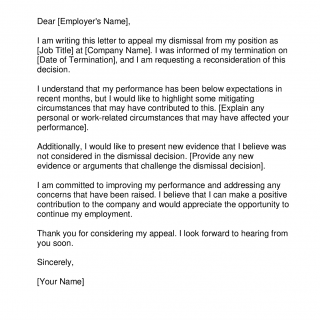Dismissal Appeal Letter
A Comprehensive Guide
A dismissal appeal letter is a formal communication written by an individual who has been dismissed from their job, educational institution, or organization. The purpose of this letter is to request a reconsideration of the dismissal decision and potentially reinstate the individual.
Parts of a Dismissal Appeal Letter:
- Introduction: This section should state the purpose of the letter and provide background information about the dismissal.
- Grounds for Appeal: The individual should clearly state the grounds for their appeal and provide any supporting evidence.
- Mitigating Circumstances: If there were any mitigating circumstances that led to the dismissal, they should be highlighted in this section.
- New Evidence or Arguments: The individual should present any new evidence or arguments that challenge the dismissal decision.
- Conclusion: The letter should end with a request for reconsideration of the dismissal decision.
Important Fields:
- Date: The date the letter is written.
- Recipient: The name and address of the person or organization who made the dismissal decision.
- Salutation: The greeting used to address the recipient.
- Body: The main content of the letter.
- Closing: The closing used to end the letter.
- Signature: The individual's signature.
The parties involved in a dismissal appeal letter are the individual who has been dismissed and the person or organization who made the dismissal decision.
When writing a dismissal appeal letter, the individual should provide any relevant evidence or documentation that supports their appeal. This may include employment contracts, performance reviews, witness statements, or medical records.
Sample of Dismissal Appeal Letter
Dear [Employer's Name],
I am writing this letter to appeal my dismissal from my position as [Job Title] at [Company Name]. I was informed of my termination on [Date of Termination], and I am requesting a reconsideration of this decision.
I understand that my performance has been below expectations in recent months, but I would like to highlight some mitigating circumstances that may have contributed to this. [Explain any personal or work-related circumstances that may have affected your performance].
Additionally, I would like to present new evidence that I believe was not considered in the dismissal decision. [Provide any new evidence or arguments that challenge the dismissal decision].
I am committed to improving my performance and addressing any concerns that have been raised. I believe that I can make a positive contribution to the company and would appreciate the opportunity to continue my employment.
Thank you for considering my appeal. I look forward to hearing from you soon.
Sincerely,
[Your Name]
Dismissal appeal letters are commonly used in employment and educational settings. For example, an employee who has been terminated from their job may write a dismissal appeal letter to request reinstatement. Similarly, a student who has been expelled from school may write a dismissal appeal letter to request readmission.
Strengths:
- Provides an opportunity for the individual to challenge the dismissal decision.
- May result in reinstatement or a favorable outcome.
Weaknesses:
- May not be successful in overturning the dismissal decision.
- Can be time-consuming and require significant effort.
Opportunities:
- Allows the individual to present their case and provide new evidence or arguments.
- May result in a positive outcome for the individual.
Threats:
- The appeal may be denied, resulting in no change to the dismissal decision.
- The individual may face additional legal or financial consequences if the appeal is unsuccessful.
Alternative forms of a dismissal appeal letter may include a grievance letter or a complaint letter. These letters may be used to address issues related to discrimination, harassment, or other workplace or educational issues.
Differences:
- A grievance letter may be used to address broader workplace or educational issues, while a dismissal appeal letter specifically challenges a dismissal decision.
- A complaint letter may be used to address issues related to discrimination or harassment, while a dismissal appeal letter focuses on challenging a specific decision.
The outcome of a dismissal appeal letter can have a significant impact on the future of the individual. If the appeal is successful, the individual may be reinstated and able to continue their employment or education. If the appeal is unsuccessful, the individual may need to seek alternative employment or educational opportunities.
Dismissal appeal letters should be submitted to the appropriate person or organization responsible for reviewing appeals. The letter should be stored in a safe and secure location for future reference.

